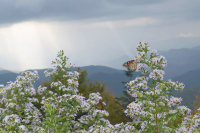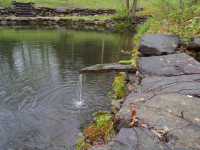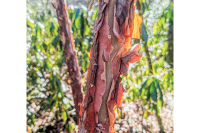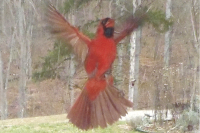Bat conservation plan out for public comment
A draft conservation plan for the federally endangered Virginia big-eared bat is out for public comment through March 1.
Endangered Species Act decisions reached for hellbender, green salamander
The eastern hellbender does not deserve listing under the Endangered Species Act, the U.S. Fish and Wildlife Service has decided, but the Hickory Nut Gorge green salamander, which was first described as a unique species in 2019, warrants a status review to consider listing.
Word from the Smokies: At 50, Endangered Species Act continues to protect life in the park
It’s no secret that the Great Smoky Mountains National Park is a hotspot of biological diversity. Not only does it offer a range of environmental conditions to support plant and animal life, no ocean or glacier has disturbed it for over a million years, giving species lots of time to evolve.
Endangered snail reintroduced to the wild
After 20 years of living only in captivity, the federally endangered magnificent ramshorn has been returned to the wild.
Endangered status proposed for three mussel species
Three freshwater mussel species have been proposed for designation as endangered species under the federal Endangered Species Act. The Cumberland moccasinshell, Tennessee clubshell and Tennessee pigtoe all occur in the Tennessee River Basin, while the Cumberland moccasinshell and Tennessee clubshell are also found in the Cumberland River Basin.
Forest plan will harm endangered bats, conservation groups say
Groups file intent to sue Forest Service
Through National Geographic Photo Ark, people can look endangered wildlife in the eye
Joel Sartore lives in Lincoln, Nebraska, but he — and his camera — are constantly on the move.
The Naturalist's Corner: Could the environment be, once again, a game changer?
I ran into a fellow at Ingles just the other day. Regrettably, I don’t remember his name, but I run into him occasionally around town and have for years. And I definitely should remember his name because he is a loyal follower of the “Naturalist’s Corner” and he is crazy bout his birds. Every time I see him he has some encouraging words regarding a recent column and/or a recent bird-related anecdote to share.
More owl pellets
I mentioned in last week’s Naturalist’s Corner that I found the decision by U.S. Fish & Wildlife to kill barred owls in an effort to save spotted owls intriguing on many levels. I will use this week’s and next week’s columns to outline a couple of those intrigues.
It’s no secret that the Endangered Species Act has become the lynchpin of conservation. Critical habitat designation has been used to preserve hundreds of thousands of acres and sometimes, as in the case of the ivory-billed woodpecker, just the perceived presence of some iconic creature can prove pivotal in raising money and/or support for land acquisition.
I don’t fault environmentalists and/or environmental organizations for using whatever means they have to protect sensitive environmental areas. And I realize that preserving habitat has become a high-stakes legal enterprise requiring legal underpinnings like critical habitat designation that comes with the Endangered Species Act.
But I often think that we, as environmentalists, have the cart before the horse. To paraphrase James Carville’s succinct advice to then presidential candidate Bill Clinton – when it comes to protecting species – it’s the habitat, stupid. Protect the habitat and you’ve de facto protected all the organisms that call said habitat home. Perhaps habitat is too ambiguous or too amorphous for people to connect with, while a spotted owl or an ivory-billed woodpecker is more tangible.
Or perhaps it’s just so intuitive that we don’t consciously focus on it. I mean, if you’re a photographer and you want to get some good butterfly shots, where do you go? You go where there are lots of blooms – why – because it’s the right habitat. If you’re a hunter or a fisherman or a birder or a biologist you can simply look around you and you can list a suite of species that you would expect to encounter at that location.
If you take a spotted owl out of old growth forest, or take an ivory-billed woodpecker out of bottomland hardwoods they won’t survive. Now, I’m not saying you couldn’t raise them in captivity. I’m saying they are part of a larger whole. They are part of an ecosystem – a habitat and they have evolved with that habitat and they depend on it for their existence. And there are any number of other organisms that depend on that habitat, some we’ve probably never even heard of.
The All Taxa Biodiversity Inventory has turned up more than 900 species new to science in a habitat that is largely second growth and sees millions of visitors a year. What might be discovered if thousands of acres of old growth and/or bottomland hardwoods were afforded the same kind of scrutiny?
At this late date of plunder of natural ecosystems in this country and around the world, we can’t afford to take our eye off any tool that gives us leverage to halt it. But we need to redouble our efforts to focus on a larger, more holistic, more sustainable picture.
Aldo Leopold, often called the father of conservation, once stated, “To keep every cog and wheel is the first precaution of intelligent tinkering. ...” Yet here we are, destroying entire ecosystems and we don’t even have a parts list. We have no idea of what we are destroying. We need to put the horse back in front of the cart.
There must be a way. I mean if the Supreme Court can give corporations individual rights, why can’t we list endangered habitats?
(Don Hendershot is a writer and naturalist. He can be reached a This email address is being protected from spambots. You need JavaScript enabled to view it..)
Elk delisting draws ire of protectors
“Elk don’t know how many feet a horse has.”
That’s the advice Bear Claw Chris Lapp gave Jeremiah Johnson as the pair hid behind their horses while stalking elk in the eponymous Robert Redford film. Well, according to Jackson County Commissioner Tom Massie, elk don’t know the boundaries of the Great Smoky Mountain National Park either.
“I truly believe we need an elk management plan because the population will continue to grow and the elk don’t recognize the boundaries of Smoky Mountain National Park,” said Massie, representing the North Carolina Wildlife Federation.
While elk are protected inside the park’s boundary, they could lose their status as a species of special concern when wandering onto private property under a proposed change by the N.C. Wildlife Commission.
Hunting elk would still be illegal but private landowners could shoot elk causing property damage. Under the current rules, landowners are supposed to get a permit before shooting problem elk.
Massie was one of a host of people who turned out at a public hearing in Sylva last week on the rule change. With a herd population of only 110, the loss of even a few elk at the hands of careless private landowners could jeopardize their long-term viability, according to opponents of the rule change.
Bob Miller, a spokesperson for the Smokies, said that over a third of the herd now lives outside the park’s boundaries in Haywood County and the Cherokee Reservation.
David Cobb, chief of the wildlife management division for the North Carolina Department of Environment and Natural Resources, said he had no way of knowing what the death of even a few elk would have on the herd.
“I can’t say what the death of one elk would do because I haven’t done the population study,” Cobb said.
Massie called on the N.C. Wildlife Commission to establish a management plan for the elk, something the state currently lacks.
Brad Howard, a wildlife biologist with the N.C. Wildlife Resources Commission, said elk will essentially still be protected even though they won’t have special concern status.
“People seem to be concerned that people will start shooting elk at leisure,” Howard said. “That is not the case. Our enforcement guys are going to want to know why you shot this elk and show us the property damage that warrants why you shot this elk. There are very specific parameters and you have to justify the animal was in fact doing damage.”
Dan McCoy, former tribal chairperson of the ECBI, traveled to the meeting with his son Connor to speak up for the elk. McCoy told commissioners he’d purchased the boy a lifetime membership to the Rocky Mountain Elk Foundation in the hopes that one day he would be able to hunt the animals.
“Our people are proud of these elk. They’re proud they’re there, but they still need our protection,” he said.
People who have put their time and money into establishing a healthy elk herd in Western North Carolina are demanding that the animals retain their status as a species of special concern.
“Listen to the hearts and minds of the people on this because that’s really what this is all about,” Ramona Bryson said.
The Rocky Mountain Elk Foundation and Friends of the Smokies led a massive fundraising effort that garnered over $1.2 million to support the reintroduction project. A satellite herd has taken up residence on land owned by the Eastern Band of Cherokee Indians, contributing to the sentiment that the N.C. Wildlife Commission is not the only stakeholder in the debate over the animals’ future.
Ray Bryson, another member of the Rocky Mountain Elk Foundation, was one of the volunteers who drove 59 hours round trip to Alberta, Canada, to deliver the elk to the park when the herd was first established. Bryson urged the Wildlife Commission to work with the national park and the tribe to establish a management plan that would expand the elks’ range into the Pisgah and Nantahala national forests.
Cobb said his staff met with members of the Rocky Mountain Elk Foundation in person before the hearing and the discussion concerning their protected status is ongoing.
“This is nowhere close to a done deal,” said Cobb.









